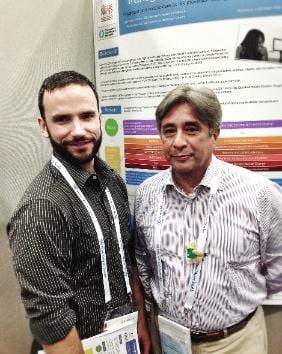A new survey of gay and bisexual men shows almost half report having unprotected sex always, often or sometimes.
Of the 725 men surveyed, most say they are educated about HIV/AIDS, and fear getting infected or re-infected.
Dr Freddy Molano and Renato Barucco of New York’s non-profit Community Healthcare Network (CHN) focused on men who use apps such as Grindr, Scruff, Manhunt and Growlr to meet sexual partners.
The focus of the survey, which received replies from men in Australia, South America, Eastern Europe, the UK, Canada, and mostly the US, was to gain insight into men’s perspectives on HIV/AIDS and unprotected sex. It also included an optional section asking respondents why they might take risks during sex.
According to the findings, 81 percent of respondents know HIV is transmitted through “unprotected anal sex, vaginal sex and, less frequently, oral sex.”
About 68 percent are afraid to be infected or re-infected and believe people should be more concerned about the epidemic.
A “vast majority” considers barebacking dangerous and believes barebackers know the risks.
Almost 47 percent of respondents admit to barebacking “always, often or sometimes,” while almost 54 percent say they never have unprotected anal intercourse.
Barucco says respondents have unprotected sex primarily because condoms don’t feel good (almost 85 percent); they act impulsively (74 percent); or they are under the influence of drugs and alcohol.
Vancouver therapist Bill Coleman, who has worked with the HIV community for more than 25 years, adds that people are often not assertive enough to insist on condom use. “Part of it is, ‘if I insist you use a condom, then I’m accusing you of being positive or you are going to think I am positive.’”
He says often people feel vulnerable in hookup situations, or they’re expecting hot sex only to find themselves in a “boring negotiation” that may put people off.
Coleman says people are not out looking to get infected, and know that fucking without condoms is a risk, but it happens anyway.
Wayne Robert, executive director of Vancouver’s Health Initiative for Men (HIM), says the CHN study is one of the first he’s seen that investigates the apps connection. HIM, too, is interested in how men meet.
“The percentage of times where guys are saying that they met their last sexual contact online has been rising, and that’s been going on for a long time,” he notes.
“At the beginning of last year, we said it would be helpful to serve our patients better to find out what’s going on on these apps,” Barucco says, adding that the study did not specifically investigate a correlation between an increasing use of apps and an increase in HIV infections among men who have sex with men. He notes that some of the apps actually work with HIV prevention initiatives.
Robert says the numbers in the CHN study are somewhat similar to those in the ManCount study conducted in Vancouver bars, clubs and cafes in 2008.
ManCount found 59 percent of men surveyed said they used a condom the last time they had anal sex, while almost 40 percent didn’t.
Hookup app users may be more sexually active than average gay men, Robert suggests. “It wouldn’t surprise me to find out that those numbers were higher.”
Still, Robert says all kinds of people engaging in all kinds of behaviour are at risk.
“If you’re having unprotected anal sex with somebody whose status you don’t know, or aren’t entirely sure of, and if you’re not getting tested on a regular basis, then there’s a potential for a risk.”
That’s the important message, he says, regardless of whether you’re finding guys “through an app or Sunday school.”
There’s great diversity in men’s sexual lives and experiences, Robert says, pointing out that those who use apps like Grindr may need messages tailored to their needs. “Also we need to ensure that we’re not then saying those are the only guys who need to hear these messages. The fact is that anyone can find themselves in a situation where they’re exposed.”
Molano and Barucco hope the study will be helpful in developing different ways to deliver prevention messages.
“We have spent a lot of money and time on condom initiatives, and I’m pretty sure that many people are using condoms, but the reality is other people have decided that they would rather have sex without condoms,” Molano says.
Given the high rates of at least occasional barebacking, the CHN researchers recommend increased use of pre-exposure prophylaxis (PrEP) pills in the gay community.
Last year, the US Food and Drug Administration (FDA) approved Truvada, a PrEP drug that could significantly reduce the risk of HIV infection in uninfected individuals. It was approved for use in conjunction with other safer-sex tools such as condom use and regular HIV testing.
“If you do it as part of an intervention, that you go to counselling, education, and have a baseline to know that you are negative, that your partner is positive, and also looking at the viral load of your partner, that could be of great help,” Molano suggests.
Robert says HIM is looking at all kinds of strategies, from condom negotiation to PrEP. He says it’s “really early days” for PrEP, noting that it hasn’t been tried with significant numbers of gay men for significant periods of time.
“The concern around that is whether people would then start to rely on that as a stand-alone. It’s not intended that way.”
Molano says he’s never been a strong believer in condom use as prevention, even though it’s useful and works.
“The secret is to meet your patients where they’re at,” Barucco says. “If they don’t want to hear condoms, you can mention it as much as you want, you’re not going to achieve any results.”
Coleman agrees. “We have sex because it’s fun, and it’s a connection, and negotiation of condoms can really get in the way of that.”
Condom use has been the message for 20 years, and it’s not sensitive to reality, Coleman continues. “If it were just a matter of people needing to know that, we wouldn’t have problems with people getting infected now.”
Barucco says it’s not a question of abandoning the strategies of the past. “We just want to add on to it, and maybe using treatment as well. We are already using treatment as prevention, not so much in terms of pre-exposure prophylaxis, but in terms of treating the positive.”
Molano says a key element is empowering people with relevant information so that they can make the right decision for their circumstances. “We cannot be judgmental,” he adds.


 Why you can trust Xtra
Why you can trust Xtra


